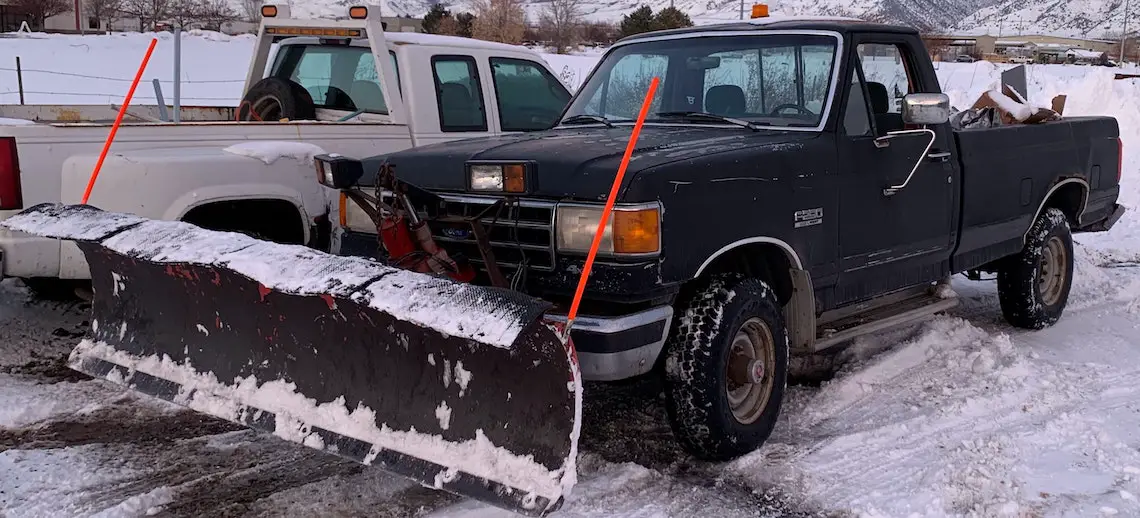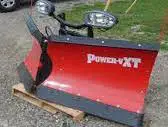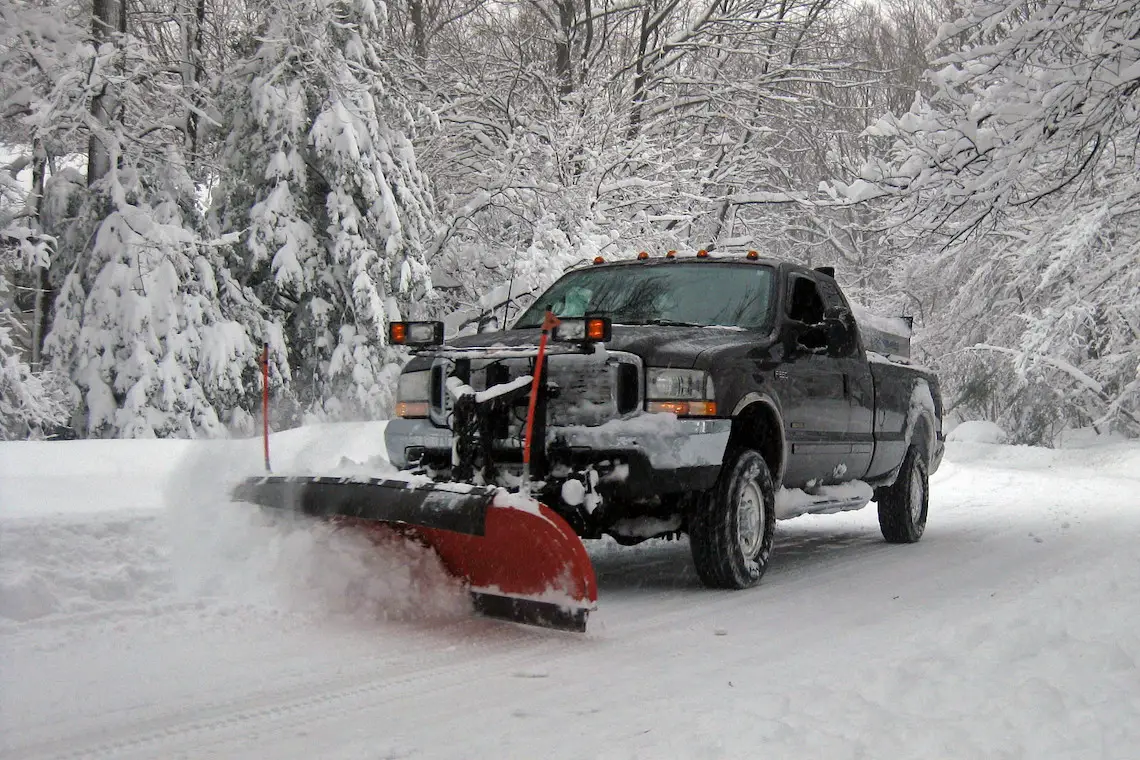Having lived in mountainous snow country since the winter of 2003/2004 I have gained experience with both 2wd and 4wd snow plowing.
This article addresses snow plowing with a 2wd vehicle.
You can plow snow with a 2wd truck IF you follow a few simple rules such as:
- plowing level parking lots and driveways
- having sufficient weight in the back end
- having aggressive tires with studs or chains on the rear tires and
- having a cell phone to call for help when you get stuck
Where Can I Plow With A 2wd Truck
Unless you are a Professional Snow Plow Truck Driver with a large plow truck manufactured specifically for plowing snow a 2wd truck will limit where you can safely plow.
Highway Department snow plow trucks like those used by the North Dakota Highway Department weigh 58,740 pounds and are designed for heavy duty snow plowing.
If you are thinking about using a 2wd pickup truck to plow snow, you should limit your plowing to level, smooth surfaces such as driveways and parking lots.
With experience and the ability to feel the trucks response to the conditions you will master how to use the throttle to move the truck without spinning the rear wheel that gets the power.
When you have reached this skill level you may be able to extend your plowing to slight downhill stretches of road that are not crowned and do not have curves in them.
Weight Or No Weight In The Back
Weight in the back of a pickup truck equals traction.
A snow plow and attachments for a pickup truck can weigh 500 pounds or more.
This additional weight on the front end acts like a pivot that removes an equal amount of weight from the back end of the truck.
If you only add weight equal to the weight of the plow and attachments to the rear of the truck you have only the same traction as you would have if the rear end was empty.
And there was no plow on the front.
The weight added to the back end must be at least twice as much as the weight of the plow and attachments on the front end to have enough traction to plow snow with a 2wd pickup truck.
Aggressive Tires Are Needed
To plow snow with a 2wd pickup truck you need aggressive studded tires on all four wheels.
Or aggressive tires on all four wheels with chains on the rear wheels.
It is the aggressive tread combined with the studs or chains and enough weight in the rear of the truck that gives traction.
The aggressive tread combined with studs or chains is much more important than the width of the tires.
Automatic Or Standard Transmission
With a standard transmission you can ease out on the clutch without spinning the rear wheel that gets the power and loosing traction.
When you loose traction and the wheel spins, you can’t plow.
If you try to ease forward with an automatic you cause excessive heat buildup in the transmission. When you do this enough times you have to rebuild the automatic transmission.
Snow plowing will cause a clutch or an automatic transmission to fail faster than if you were not snow plowing.
A clutch replacement is less expensive than an automatic transmission rebuild.
You Will Get Stuck
Everyone who snow plows with a 2wd pickup truck will end up getting stuck and needing to be pulled out.
Keep a charged cell phone with you so you can call for help.
The three most common times to get stuck are:
- When trying to push snow too far and the weight of the snow causes the rear wheels to spin and dig into the snow pack or snow/ice mix
- When piling snow up causes the plow to get hung up on the pile
- When you raise the plow to back up the pivot action of lifting the blade will transfer weight from the back to the front of the truck
All three of these situations increase your chances of getting stuck.
And spinning the rear wheel even with rear chains.
In each of these situations you will need to be pulled out.
This is because a 2wd pickup truck does not have the ability to extract you from these problems like a 4wd pickup truck can.
Open Rear End Or Limited Slip
With a 2wd vehicle only one rear wheel gets power. This is also called an open rear end.
The power typically goes to the wheel with the least resistance to motion.
In a limited slip rear end, also called posi-trac, both rear wheels get power.
So you have twice the ability to get traction and to start moving.
This can be an advantage when plowing snow with a 2wd pickup truck.
A lower rear end ratio will improve the 2wd pickup truck’s ability to plow snow.
Because it makes the engine/transmission more efficient under a load.
Rear gear ratios in the range of 3.42 – 3.73 that are common in 2wd pickup trucks make it harder to push wet, heavy snow.
Rear gear ratios in the 4.10 – 4.88 range make pushing wet, heavy snow with a 2wd pickup truck much easier.
And can reduce the number of times the truck gets stuck and needs to be pulled out.
The 4.10 – 4.88 rear gear ratio decreases the problem of overheating an automatic transmission and engine and can prolong their life.
Limited Slip Is Not A 2wd Cure All
A limited slip rear end will help in pushing snow, but not in backing up when the plow gets hung up on a pile of snow.
If you are pushing snow uphill with a 2wd pickup truck and limited slip the truck can tend to go sideways as the weight of snow builds up in front of the plow.
If starting from a dead stop to push snow uphill on a crowned road with a 2wd pickup truck and limited slip, you can expect to go sideways off the road.
By contrast, if you are snow plowing with a 4wd pickup truck the power to the front wheel aids in keeping you on the road.
Effect Of Wheel Base On Traction

A short wheel base single cab pickup truck tends to put more weight on the rear wheels.
Placing weight in the rear of a short wheel base truck to offset the weight of the plow and attachments on the front decreases the pivot effect.
This is because the pivot point is closer to the trucks center making it harder to transfer the weight to the front.
This gives more rear wheel traction.
Is Front Suspension Adequate
Will the front suspension support a snow plow and attachments?
Unless the pickup truck came from the factory with a snow plow package you will need to make some changes if plowing more than your driveway.
A 500 pound or heavier blade puts a lot of extra stress on ball joints, tie rod ends, bearings, spindles, front springs and brakes.
All these components need to be beefed-up to prevent premature failure.
Even then, expect them to need replacing more often than if no plowing was done with that truck.
Snow Plow Size
Snow plows for pickup trucks range in size from 7.5 feet wide to 10 feet wide.
And in weight from 500 to 1000 pounds.
Snow plow blade designs range from straight blade, to winged blade to V-shaped blades.

Winged blades can be configured on the fly from straight to having the outer 1 foot of each end angling inward in a scoop fashion.

V-shaped blades have a joint in the center.
And can be configured on the fly from various angles of a V to straight.
A dealer selling snow plows can give guidance as to what type and size of plow is best for your truck.
Preventing Automatic Transmission Failure
Heat is one of the main killers of automatic transmissions.
Snow plowing is hard on the automatic transmissions present in many pickup trucks.
This is especially true of 4 speed automatic transmissions that have overdrive as the forth gear.
Unless a 4 speed overdrive transmission was designed for overdrive to be used in towing heavy loads, do not attempt to snow plow in overdrive.
Starting up slow and easy while pushing snow can build up heat in the transmission very rapidly.
Even pushing wet snow that is only 3 or 4 inches deep for any distance can cause heat build up in automatic transmissions.
If you plan on snow plowing and your truck does not have a transmission fluid cooler on it, you need to have one installed.
Additionally, a transmission temperature gauge will help preserve your automatic transmission.
It is good practice to keep the transmission temperature below 200 degrees F.
A temperature gauge will help you know what conditions raise the transmission temperature and what to do to lower it.
Preventing Premature Engine Problems
Engine overheating is a major cause of engine failure.
What many do not realize is that engine oil temperature can be as important to preventing engine failure as the engine water temperature.
If you are planning on doing a lot of plowing, a good investment is an engine oil cooler.
Other causes of engine failure include:
- Engines that develop insufficient torque to start the truck moving under a load and keep it moving as the load increases
- Engines with insufficient horsepower to overcome the inertia of a dead stop while pushing a load that continues to increase
With a 2wd pickup truck you will need a larger engine with more horsepower.
And torque than you would need with a 4wd pickup truck.
A minimum of 250 horsepower and at least 250 foot pounds of torque will be needed to push snow with an 8 foot blade.
When the snow is wet or is deeper than 4 to 6 inches.
Ideal 2wd Pickup Truck For Plowing Snow
The ideal 2wd pickup truck for snow plowing would have:
- a single cab, short bed pickup truck
- either a standard transmission or an automatic with a transmission fluid cooler and temperature gauge
- beefed up front suspension to handle the extra weight of a plow and attachments
- at least twice the weight of the plow and attachments in the back end
- properly sized and configured snow plow for your particular truck
- aggressive snow tires with studs on all four wheels or aggressive snow tires on all four wheels with chains on the rear wheels
- engine of at least 250 horsepower with at least 250 foot pounds of torque
- rear end gear ratio between 4.10 and 4.88 to make pushing wet, heavy snow easier and reduce the number of times you would need to be pulled out when stuck
If it was equipped with a limited slip rear end beware of pushing snow uphill or on a crowned road.
Summary
Following the guidelines set out above, you can snow plow with a 2wd pickup truck.
However, most pickup trucks that are used to plow snow in mountainous areas are 4WD trucks.

